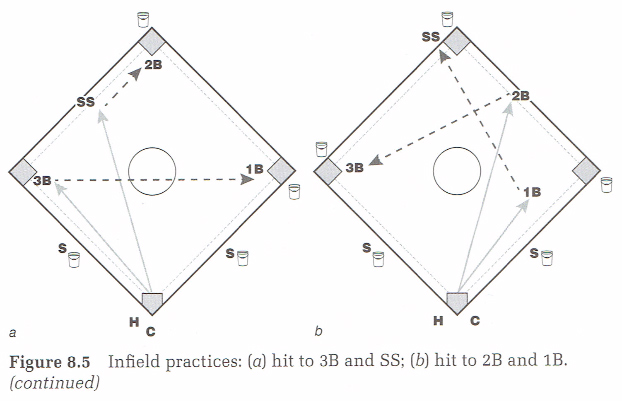| Indoor Skill Practice |
| By: Celeste Knierim
Originally Published in: Practice Perfect Softball - NFCA Provided by: Human Kinetics Divide the gym in half and use half for bunting and slapping practice and the other half for fielding practice. Side A - Outfielders and Pitchers Practice Bunting and Slapping Drill 1 Four players bunt for a hit off a machine without defense. The rest of the players just shag and return balls to the person at the machine. The players bunting get one pitch for a bunt on the run. The players do this quickly so that they get the idea to be ready to run out of the bunt. Setup The person feeding the machine puts a ball in as quickly as possible and continues to feed the machine at a steady pace. Obviously, the feeder has to adapt the speed to the ability of the players who are bunting but will soon come to a good rhythm. Execution The first player bunts on the run, runs 5 to 10 steps, and then goes to the end of the line. The second player bunts immediately after the first one and so on. Coaching Points • The player should transfer her weight to the front foot when starting her run. The back foot is off the ground on contact. • The hands on the bat are split so that they are stronger when contacting the ball. The wrist on the bottom hand should be pointed down to make it stronger. The top hand should grip the bat with at least three fingers and the thumb. • Using fewer fingers makes the hand weaker. When either hand is in a weak position, the player is at higher risk of fouling the ball off against faster pitches. • The bat should be level and at eye level away from the body. • The ball is contacted out in front of the body, and the top hand acts as a pivot point. If the player pushes the bottom hand straight out, the ball goes toward first if the batter is right-handed and toward third if the player is left-handed. If the bottom hand is pulled in as far as possible, the ball off a right-handed batter will go toward third and the ball off a lefty will go toward first. • When a lefty wants to do a drag bunt toward first, it is easier to use just the top hand and take the bottom hand off the bat. The bat in this case needs to be in the high strike area, parallel to the ground. The bottom of the bat and knob should be against the player's forearm for stability. • After all balls have been used, ideally after at least two buckets of balls, switch to four new players. Each group should practice bunting a couple of times if possible. Variations • When all players have bunted numerous times, add a defense. The drill will go slower because the defenders are throwing the ball to first. • Do the same drill but switch to slapping. • Do slapping against a defense. Side B - Infielders and Catchers Do Infield Practice Drill 1 Setup Maximize the number of repetitions for each player by alternating hits to third base and shortstop and having the third baseman throw to first and the shortstop throw to second. Execution • The players receiving the throws can either put the ball in a bucket or toss to a specific shagger. The hitter put balls in play quickly by hitting to the shortstop as the first fielder is throwing, doing this numerous times (figure 8.5a). • The hitter switches to hitting to the second baseman who throws to third and to the first baseman who throws to the shortstop covering second. The hitter needs to pay attention to where the players are so that no one is in a throwing lane. Repeat until all players have had their workouts (figure 8.5b).
• The hitter switches to hitting to the third baseman who now throws to second and to the shortstop who now throws to first (figure 8.5c). • The hitter switches to hitting to the second baseman who now throws to the short-stop covering second and to the first baseman who throws to third (figure 8.5d). Drill 2 Players field various types of hits. Execution The coach hits to the infielders by hitting hard grounders, soft grounders, line drives, balls over the head, bunts, short hops, backhand shots, hits up the middle, hits in the gaps, hits down the lines, foul-ball pop-ups, foul-ball line drives, and balls that require players to throw on the run. Coaching Point For a couple of these kinds of balls, throwing the ball to the desired area is easier than hitting the ball with a bat. Too much time is wasted trying to hit the ball in shallow areas like just over first or third, so you can just throw it there for better accuracy. Keeping the practice moving is extremely important in keeping the players involved mentally. Players switch to the other side of the gym. For side 2A, infielders and catchers do the slap and bunt drills described earlier. For side 2B, outfielders practice fielding (because the gym probably has a low ceiling, the high fly ball drills have to be outside). |









